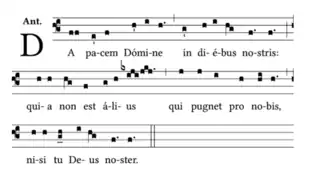Da pacem, Domine
Da pacem Domine (Give peace, Lord) is the incipit of two different Latin texts, a hymn and an introit. Both have been the base for compositions to be used in church liturgy, beginning with chant. Paraphrased versions of the hymn were created by Martin Luther in German in 1529, "Verleih uns Frieden", also set by several composers. In English, the hymn entered the Book of Common Prayer, "Give peace in our time, O Lord".

History and musical settings
Latin
The text is a 6th or 7th-century hymn based on biblical verses 2 Kings 20:19, 2 Chronicles 20:12,15 and Psalms 72:6–7.[1]
Settings of the Latin hymn include Da pacem Domine by Arvo Pärt (2004) or Da pacem Domine by Juan María Solare (2018).
The inscription "da pacem domine" appears beside the figure of an angel playing on lute, on the so-called Jankovich saddle (c. 1408-1420), attributed to King Sigismund of Hungary.
German
Martin Luther wrote a paraphrase in German, "Verleih uns Frieden".[1] A second stanza, beginning "Gieb unsern Fürsten", was later added to Luther's text by Johann Walter and in this form the hymn endured as a chorale, appearing in the cantatas of Johann Sebastian Bach.[2] Other settings include a motet in the collection Geistliche Chormusik by Heinrich Schütz (published 1648), and Verleih uns Frieden, a chorale cantata by Mendelssohn.
English
A version in English, "Give peace in our time, O Lord", is part of the Book of Common Prayer.[1][3] The similar phrase Peace for our time has been used in political contexts.
The introit
A different text with the same first line is the Introit for Pentecost XVIII, based on Sirach 36:18 and Psalms 122:1 (Psalm 121 in the Vulgate)
See also
References
- "Da pacem Domine, in diebus nostris". hymnary.org. Retrieved 10 November 2014.
- "Chorale Text: Verleih uns Frieden gnadiglich - Text & Translation". www.bach-cantatas.com. Retrieved 29 April 2020.
- "Morning Prayer. Versicles". The Book of Common Prayer.
Sources
- Da pacem Domine text and translations in the Choral Public Domain Library
- Da pacem Domine (Introit) text and translations in the Choral Public Domain Library
- Verleih uns Frieden German hymn in the Choral Public Domain Library